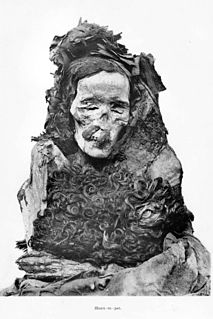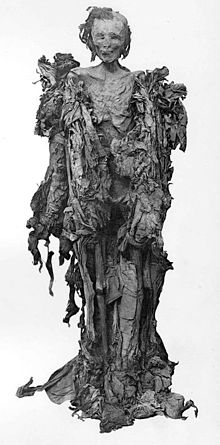
Ahmose I was a pharaoh and founder of the Eighteenth Dynasty of Egypt, classified as the first dynasty of the New Kingdom of Egypt, the era in which ancient Egypt achieved the peak of its power. He was a member of the Theban royal house, the son of pharaoh Seqenenre Tao and brother of the last pharaoh of the Seventeenth dynasty, Kamose. During the reign of his father or grandfather, Thebes rebelled against the Hyksos, the rulers of Lower Egypt. When he was seven years old, his father was killed, and he was about ten when his brother died of unknown causes after reigning only three years. Ahmose I assumed the throne after the death of his brother, and upon coronation became known as nb-pḥtj-rꜥ "The Lord of Strength is Ra".

Neferkare Setepenre Ramesses IX was the eighth pharaoh of the Twentieth Dynasty of Egypt. He was the third longest serving king of this Dynasty after Ramesses III and Ramesses XI. He is now believed to have assumed the throne on I Akhet day 21 based on evidence presented by Jürgen von Beckerath in a 1984 GM article. According to Papyrus Turin 1932+1939, Ramesses IX enjoyed a reign of 18 years and 4 months and died in his 19th Year in the first month of Peret between day 17 and 27. His throne name, Neferkare Setepenre, means "Beautiful Is The Soul of Re, Chosen of Re." Ramesses IX is believed to be the son of Mentuherkhepeshef, a son of Ramesses III, since Mentuherkhopshef's wife, the lady Takhat bears the prominent title of King's Mother on the walls of tomb KV10, which she usurped and reused in the late 20th Dynasty; no other 20th Dynasty king is known to have had a mother with this name. Ramesses IX was, therefore, probably a grandson of Ramesses III.
Ahmose is an Ancient Egyptian name meaning "The Moon is born" or "Child of the Moon". It was a very popular name in the beginning of the eighteenth dynasty.

Ahmose-Nefertari was the first Great Royal Wife of the 18th Dynasty of Ancient Egypt. She was a daughter of Seqenenre Tao and Ahhotep I, and royal sister and wife to Ahmose I. Her son Amenhotep I became pharaoh and she may have served as his regent when he was young. Ahmose-Nefertari was deified after her death.

Thuya was an Egyptian noblewoman and the mother of queen Tiye, and the wife of Yuya. She is the grandmother of Akhenaten, and great grandmother of Tutankhamun.

Seqenenre Tao ruled over the last of the local kingdoms of the Theban region of Egypt in the Seventeenth Dynasty during the Second Intermediate Period. He probably was the son and successor to Senakhtenre Ahmose and Queen Tetisheri. The dates of his reign are uncertain, but he may have risen to power in the decade ending in 1560 BC or in 1558 BC. With his queen, Ahhotep I, Seqenenre Tao fathered two pharaohs, Kamose, his immediate successor who was the last pharaoh of the Seventeenth Dynasty, and Ahmose I who, following a regency by his mother, was the first pharaoh of the Eighteenth. Seqenenre Tao is credited with starting the opening moves in a war of revanchism against Hyksos incursions into Egypt, which saw the country completely liberated during the reign of his son Ahmose I.

Senakhtenre Ahmose, was the seventh king of the Seventeenth Dynasty of Egypt during the Second Intermediate Period. Senakhtenre reigned for a short period over the Theban region in Upper Egypt at a time where the Hyksos 15th Dynasty ruled Lower Egypt. Senakhtenre died c.1560 or 1558 BC at the latest.

Ahmose-Meritamun was a Queen of Egypt during the early Eighteenth Dynasty. She was both the older sister and the wife of Pharaoh Amenhotep I. She died fairly young and was buried in tomb TT358 in Deir el-Bahari.

Ahhotep I was an ancient Egyptian queen who lived circa 1560–1530 BC, during the end of the Seventeenth Dynasty of Egypt. She was the daughter of Queen Tetisheri and Senakhtenre Ahmose, and was probably the sister, as well as the queen consort, of Pharaoh Seqenenre Tao ll. Ahhotep I had a long and influential life. She ruled as regent for her son Ahmose I for a time.

Ahhotep II was an ancient Egyptian queen, and likely the Great Royal Wife of Pharaoh Kamose.

Ahmose-Sapair was a prince of the late Seventeenth Dynasty of Egypt.

Sitdjehuti was a princess and queen of the late Seventeenth Dynasty of Egypt. She was a daughter of Pharaoh Senakhtenre Ahmose and Queen Tetisheri. She was the wife of her brother Seqenenre Tao and was the mother of Princess Ahmose.

Ahmose was a princess of the Seventeenth Dynasty of Egypt. She was the only known daughter of Seqenenre Tao by his sister-wife Sitdjehuti. She was the half-sister of Pharaoh Ahmose I and Queen Ahmose-Nefertari. Her titles are King's Daughter; King's Sister.

Ahmose-Henuttamehu was a princess and queen of the late 17th-early 18th dynasties of Egypt.

Ahmose-Henutemipet was a princess of the late Seventeenth Dynasty of Egypt. She was a daughter of Pharaoh Seqenenre Tao and probably Queen Ahhotep I. She was the sister of Ahmose I. She bore the titles King's Daughter and King's Sister.
Ahmose-Meritamon was a princess of the 17th Dynasty of Egypt, probably a daughter of pharaoh Seqenenre Tao. She is also called Ahmose-Meritamun, Ahmose-Meryetamun or just Meryetamun.
Ahmose-Nebetta was a princess during the late Seventeenth Dynasty of Egypt. She was probably the daughter of Seqenenre Tao and Queen Ahhotep I. She was the sister of Pharaoh Ahmose I.

Ahmose-Sitkamose, sometimes appearing as simply Sitkamose was a princess during the late 17th-early 18th Dynasties of Egypt.
Ramose was an ancient Egyptian prince of the Eighteenth Dynasty; probably the son of Pharaoh Ahmose I.
Meritamen, also spelled Meritamun, Merytamen, Meryetamen is an ancient Egyptian female name. Its male counterpart is Meryamen or Meryamun.
















